
Robert Anson Heinlein was an American science fiction author, aeronautical engineer, and naval officer. Sometimes called the "dean of science fiction writers", he was among the first to emphasize scientific accuracy in his fiction, and was thus a pioneer of the subgenre of hard science fiction. His published works, both fiction and non-fiction, express admiration for competence and emphasize the value of critical thinking. His plots often posed provocative situations which challenged conventional social mores. His work continues to have an influence on the science-fiction genre, and on modern culture more generally.
A future history is a postulated history of the future and is used by authors of science fiction and other speculative fiction to construct a common background for fiction. Sometimes the author publishes a timeline of events in the history, while other times the reader can reconstruct the order of the stories from information provided therein.

Sixth Column, also known under the title The Day After Tomorrow, is a science fiction novel by American writer Robert A. Heinlein, based on a story by editor John W. Campbell, and set in a United States that has been conquered by the PanAsians, who are asserted to be neither Japanese nor Chinese. Originally published as a serial in Astounding Science Fiction it was published in hardcover in 1949. It is most known for its race-based premise.
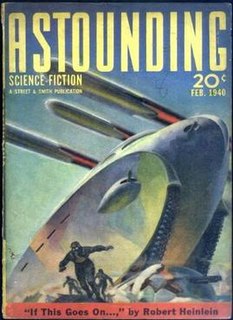
"If This Goes On—" is a science fiction novella by American writer Robert A. Heinlein, first serialized in 1940 in Astounding Science-Fiction and revised and expanded for inclusion in the 1953 collection Revolt in 2100. The novella shows what might happen to Christianity in the United States given mass communications, applied psychology, and a hysterical populace. The novel is part of Heinlein's Future History series.
"Life-Line" is a short story by American author Robert A. Heinlein. Published in the August 1939 edition of Astounding, it was Heinlein's first published short story.

Assignment in Eternity, is a collection of four science fiction and science fantasy novellas by American writer Robert A. Heinlein, first published in hardcover by Fantasy Press in 1953. The stories, some of which somewhat revised from their original magazine publications, were:
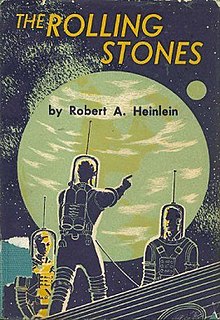
The Rolling Stones is a 1952 science fiction novel by American writer Robert A. Heinlein.
Alexei Panshin is an American writer and science fiction (SF) critic. He has written several critical works and several novels, including the 1968 Nebula Award-winning novel Rite of Passage and, with his wife Cory Panshin, the 1990 Hugo Award-winning study of science fiction The World Beyond the Hill.
In American science fiction of the 1950s and '60s, psionics was a proposed discipline that applied principles of engineering to the study of paranormal or psychic phenomena, such as telepathy and psychokinesis. The term is a portmanteau formed from psi and the -onics from electronics. The word "psionics" began as, and always remained, a term of art within the science fiction community and—despite the promotional efforts of editor John W. Campbell, Jr—it never achieved general currency, even among academic parapsychologists. In the years after the term was coined in 1951, it became increasingly evident that no scientific evidence supports the existence of "psionic" abilities.
The exploration of politics in science fiction is arguably older than the identification of the genre. One of the earliest works of modern science fiction, H. G. Wells’ The Time Machine, is an extrapolation of the class structure of the United Kingdom of his time, an extreme form of social Darwinism; during tens of thousands of years, human beings have evolved into two different species based on their social class.
Social science fiction is a subgenre of science fiction, usually soft science fiction, concerned less with technology/space opera and more with speculation about society. In other words, it "absorbs and discusses anthropology" and speculates about human behavior and interactions.
The science fiction writer Robert A. Heinlein (1907–1988) was productive during a writing career that spanned the last 49 years of his life; the Robert A. Heinlein bibliography includes 32 novels, 59 short stories and 16 collections published during his life. Four films, two TV series, several episodes of a radio series, and a board game derive more or less directly from his work. He wrote a screenplay for one of the films. Heinlein edited an anthology of other writers' SF short stories.
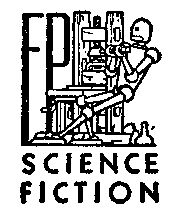
Fantasy Press was an American publishing house specialising in fantasy and science fiction titles. Established in 1946 by Lloyd Arthur Eshbach in Reading, Pennsylvania, it was most notable for publishing the works of authors such as Robert A. Heinlein and E. E. Smith. One of its more notable offerings was the Lensman series.
"Let There Be Light" is a science fiction short story by American writer Robert A. Heinlein, originally published in Super Science Stories magazine in May 1940 under the pseudonym Lyle Monroe. It is the second story in his Future History and was included in the first collection, The Man Who Sold the Moon, but was omitted from the omnibus collection The Past Through Tomorrow. This story draws on Heinlein's early leftist ideas, and makes references to George Bernard Shaw's The Apple Cart.
The Heinlein juveniles are the science fiction novels written by Robert A. Heinlein for Scribner's young-adult line. Each features "a young male protagonist entering the adult world of conflict, decisions, and responsibilities." Together they tell a loosely-connected story of space exploration. Scribner's published the first twelve between 1947 and 1958, but rejected the thirteenth, Starship Troopers. That one was instead published by Putnam. A fourteenth novel, Podkayne of Mars, is sometimes listed as a "Heinlein juvenile", although Heinlein himself did not consider it to be one.

Off the Main Sequence: The Other Science Fiction Stories of Robert A. Heinlein (ISBN 1-58288-184-7) is a collection of 27 short stories by American writer Robert A. Heinlein, including three that were never previously collected in book form.
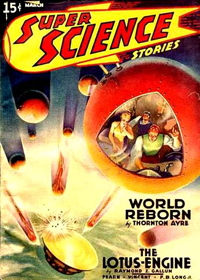
Super Science Stories was an American pulp science fiction magazine published by Popular Publications from 1940 to 1943, and again from 1949 to 1951. Popular launched it under their Fictioneers imprint, which they used for magazines, paying writers less than one cent per word. Frederik Pohl was hired in late 1939, at 19 years old, to edit the magazine; he also edited Astonishing Stories, a companion science fiction publication. Pohl left in mid-1941 and Super Science Stories was given to Alden H. Norton to edit; a few months later Norton rehired Pohl as an assistant. Popular gave Pohl a very low budget, so most manuscripts submitted to Super Science Stories had already been rejected by the higher-paying magazines. This made it difficult to acquire good fiction, but Pohl was able to acquire stories for the early issues from the Futurians, a group of young science fiction fans and aspiring writers.
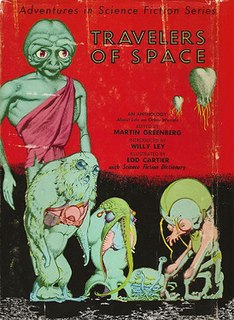
Travelers of Space is a 1951 anthology of science fiction short stories edited by Martin Greenberg. The stories originally appeared in the magazines Planet Stories, Astounding SF, Thrilling Wonder Stories and Startling Stories.
Beyond Doubt is a science fiction story written by Robert A. Heinlein, originally printed in Astonishing Stories in April 1941 under the pen name "Lyle Monroe and Elma Wentz".

Futuria Fantasia was an American science fiction fanzine created by Ray Bradbury in 1938, when he was 18 years old. Though only four issues of the fanzine were published, its list of contributors included Hannes Bok, Forrest J. Ackerman, Henry Kuttner, Damon Knight, and Robert A. Heinlein.









